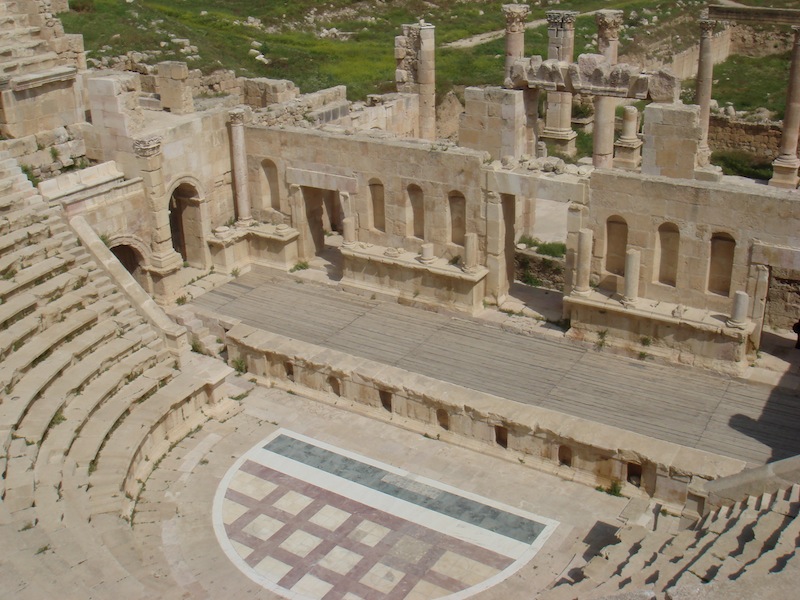I associate coach tours with infirm pensioners, but that didn’t stop us joining one during our fortnight in Jordan. We were easily the youngest on board but our guide Ibrahim was invaluable and we got to see much more of the country than we would have done on our own.
Take just one day, which started with a treasure of the Roman Empire and finished with a remarkable inland sea.
We’d already spent several days touring some of the best sights the country has to offer and were looking forward to a relaxing week by the sea in Aqaba. But first, Jerash and the Dead Sea beckoned.
We’d stayed the night at the plush Marriott hotel in Amman, some distance from the heart of the capital. Graham was suffering with a stomach upset and opted to stay in bed so, rather than going out, I loitered in the Marriott’s bars with cold lager for company.

Fortunately, he was on the mend by the morning, when we experienced waiter service at its most average during breakfast.
The weather was on the mend too after our cloudy trip to the desert castles the day before. As we drove out through some surprisingly prosperous city suburbs, the sun shone happily on us.
Jerash (or Gerasa), a busy town wrapped around one of the great Roman cities of the eastern empire, lay some 30 miles north of Amman along the road to Syria.
Great it may have been but centuries of earthquakes, bloody wars and development sealed the fate of old Jerash, which mostly lay buried beneath the modern town until the early 19th century. A team of archaeologists helped bring the Roman ruins back to life in the following decades.

We left our coach and were immediately confronted by the monumental Hadrian’s arch, an imperial introduction to the remains that stood beside what would’ve been the venue for popular chariot and horse races, the hippodrome. We walked on to explore many of the site’s other highlights, kicking up dust in the heat and appreciating the occasional splash of colour provided by the abundant wild flowers that had seeded themselves in the grassy banks.
The Grand Oval Plaza must’ve been a busy meeting place in Roman times, where residents traded and socialised.
But the theatres would’ve been just as popular with locals hungry for entertainment. With an Arab bagpipe band playing beside the stage of one grand example (for reasons I can’t explain), we explored its steep seating areas and I struggled with something approximating vertigo.

We toured colonnaded streets, the Temple of Artemis with its architectural Corinthian columns and admired the well-preserved mosaic floor in one of several Byzantine churches that were built later on the site.
For fans of Roman remains, and I’m one, Jerash was a memorable place. Incredibly, though, we learnt that 80% of it remains hidden underground, waiting to be explored.
We didn’t have long enough there as we had to leave for the two-hour drive to the Dead Sea. And as we travelled south we left the green and fertile countryside of the north behind, and discovered landscapes that were grey, brown and arid, marked by steep-sided hills and dramatic gorges.

Surprisingly, perhaps, the country around the Dead Sea itself wasn’t particularly picturesque. We parked up at one of the resort hotels – the Movenpick – that are strung along the Jordanian side and had lunch before changing into our swimming cossies.
Sadly, the Dead Sea is dying. The famous River Jordan that feeds it is now just a trickle thanks to too much extraction, but what remains of this famous stretch of water looked calm and inviting. We found a man-made sandy beach but had to clamber painfully over rocks to get into the lake. We were guided in by men holding bottles of fresh water, ready to wash out eyes splashed with the salty water, which can sting horribly.
And what a weird experience the Dead Sea proved to be. Once we were lying in the incredibly bouyant water, it was almost impossible to turn over, let alone stand up. I felt I had no control at all over my own body.
The water also had an oily consistency to it that was really quite pleasant.

Out of the sea, we plastered ourselves in Dead Sea mud to get the maximum mineral benefits. And, sure enough, a few hours later (and for several days to come) my skin felt as soft as the proverbial baby’s bum.
Again, our stay wasn’t nearly long enough. We jumped back into the coach for our drive to Aqaba, passing some impressive scenery by the Dead Sea. We stopped to see the natural rock sculpture known as Lot’s Wife, and spotted huge salt formations on the water’s edge. We paused at the point where the Wadi Mujib gorge dramatically ends.
As the sun began to sink, we drove on through the Jordan Valley, through a landscape of plateaus and peaks, salt pans and patches of greenery. Security was tight and black bedouin tents dotted the landscape, but how the locals, with their manky goats and sheep, managed to scrape a living out of that arid landscape, I have no idea.
I dozed. And dreamt of a week by the Red Sea…

